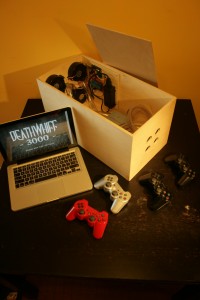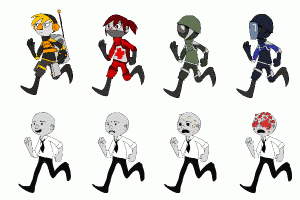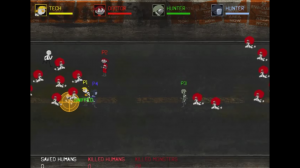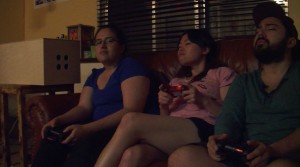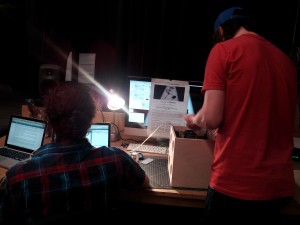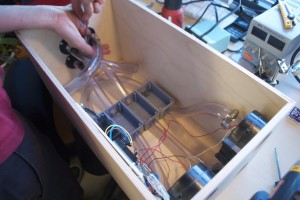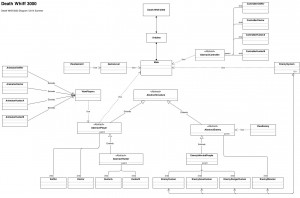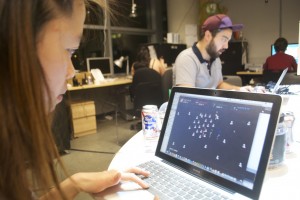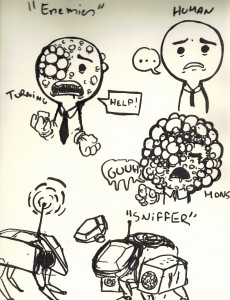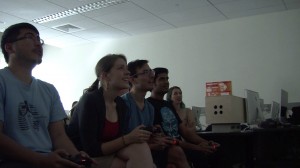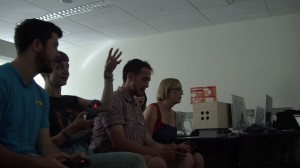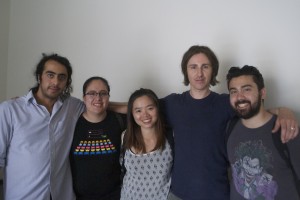Deathwhiff 3000 is a four-player cooperative video game developed during the summer of 2014 as part of a game design class taught by Heather Kelley, “Playing with the Senses”, at Concordia University in Montreal. Presented with the challenge to integrate the sense of smell into a playful interaction, a team of artists developed Deathwhiff 3000, a game that integrates a system for scent delivery that associates key odorants with characters in the game. The Deathwhiff 3000 is the scent delivery hardware that is at once a virtual and physical device – both the characters in the game and the players in the physical world are connected through the use the device. In this way, Deathwhiff 3000 pushes the sensory experience of a traditional screen/controller game by relying on the player’s sense of smell in order to differentiate characters in the game.
Inspired by Heather’s lecture about the challenges and potential of smell, the team’s main intention was to create a playful interaction where the smell would not be a simple stimulus feedback, but rather an essential component of the game, where characters themselves would be defined by smell alone. The concept of the game changed drastically as we brainstormed, as it started with a game about being a werewolf sniffing for potential allies and enemies but morphed into a post-apocalyptic game where a virus turned its victims into zombies, and where the only way to determine whether anyone is infected is through smell.
And thus Deathwhiff 3000 was born.
The goal of the game is to kill as many zombies while trying to save as many humans as possible. In order to do so the players need to work as a team in order to achieve their goal. The players can play as either a Sniffer, a Medic, or as Hunters.
(The cast, from left to right, top to bottom: Sniffer, Medic, Hunter A, Hunter B, Cured Human, Undiagnosed Human, Curable Infected, Doomed Infected)
The Sniffer’s role is to sniff the human-looking non-player characters (NPC’s) and as they perform the ‘sniffing’ action the real-life Deathwhiff 3000 will spray a smell. It is up to the players to determine whether the smell indicates whether the NPC is clean and only in need of a vaccine, whether they are infected but still curable, or if they are doomed to die and should be finished off instead. The Medic then either cures or inoculates the target, while the Hunters–being the only characters with weapons–have to finish off the doomed NPC’s and defend both the Medic and the Sniffer. The Medic is also able to revive other player characters but cannot heal herself, and the game ends as soon as she dies.
(Ana, Milin and Oli in the middle of intense smelling action. The more pungent the smell, the least likely that the smelled target could be saved.)
As Deathwhiff 3000 was an ambitious project made in less than two weeks–admittedly we spent a whole week brainstorming and solidifying the concept–the project had its set of challenges. Initially the Deathwhiff would have been a 3D-printed Olly robot, but the robot’s design proved to be unsatisfying, as it did not fulfill the project’s needs. Thus Nima and David began building a smelling machine from scratch. They encountered challenges in the interaction design, and with coming up with a design that allowed room for the scent to spread while still being contained. David had to redo the assembly of the pipes to make sure that the airflow of the Deathwhiff was smooth. Less than three days before the deadline one of the fans–a fourth smell, coffee grains, meant to clear the nose–began overheating as it would never shut down when it had to. That nose-clearing fan had to be disabled.
(Nima and David working on the Deathwhiff machine.)
Oli and Milin’s challenges were of making the core mechanics of the game work; as interesting as a programming environment Processing might be, it is not the ideal tool for game development, as it is not optimized for heavy game experiences. The relationship between who does what at any given moment, and what the consequent feedback will be thereafter, as well as collision detection, handling of arraylists, the handling of the animations (as it is different from Unity’s) and defining which animation plays at which moment, as well as memory issues–the computers ran out of RAM whenever Milin tried to implement full animations to all the characters, to the point that most of the NPC sprites had to be cut from the game–were the core of their problems.
(Above: The diagram showing the structure of Deathwhiff 3000‘s programming.)
Three of the biggest challenges they met were pausing the game in order to give the players the opportunity to smell the emanations from the Deathwhiff, as well as implementing four different Playstation 3 controllers and accurately calculating the score throughout the game.
In short, Oli and Milin built a game engine from scratch using Processing, a programming environment that is not made for games as elaborate as Deathwhiff 3000.
Ana’s own challenges were more geared towards trying to make a cohesive aesthetic and to find an appropriate style for the game as well as making a large amount of assets in a very short time. Initially, the visual style was much more whimsical and heavily inspired by Castle Crashers and–to mesh grotesque and disturbing malformations to a more palatable style–The Binding of Isaac, but as development went on and upon hearing composer Alexander Westcott’s loop made for the game she redesigned the characters into looking less cutesy and deformed, and more elongated and gritty.
(Early concepts for the zombies and the Sniffer.)
The Sniffer in particular proved to be problematic design-wise. Initially she wanted to make the Sniffer a dog, but at the suggestion that the Sniffer had to wield equipment to provide a conceptual link between the real-life Deathwhiff and the game she started creating robot dogs, but they wouldn’t fit with the rest of the characters. In the end she made the sniffer a human being carrying a large piece of equipment, but the challenge to illustrate the act of smelling remained. She is still not satisfied with simply depicting cross-hairs on the target of the smelling.
The second challenge was to create assets quickly in order to give Milin time to implement the sprites into the game, and in the span of four days Ana produced eight spritesheets of 24 sprites each, as well as a background and varying icons to depict vaccines, cures, weapons, and a smelling target icon as well as idle sprites of every character in both directions, and a new, more exaggerated monster-like zombie that ultimately replaced the Doomed Infected with red pustules over its eyes…for a grant total of 206 assets. In the end, most of the NPC’s animations had to be cut due to memory issues with Processing.
Deathwhiff 3000 was developped using Processing and Arduino, and its sprites were made using Flash and Photoshop CS6. The Deathwhiff machine was manned with an Arduino UNO board.
